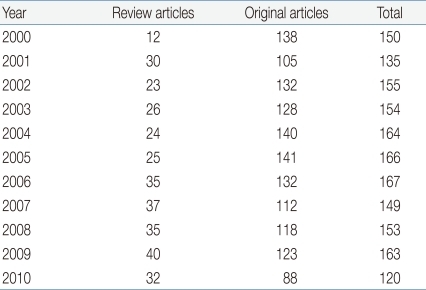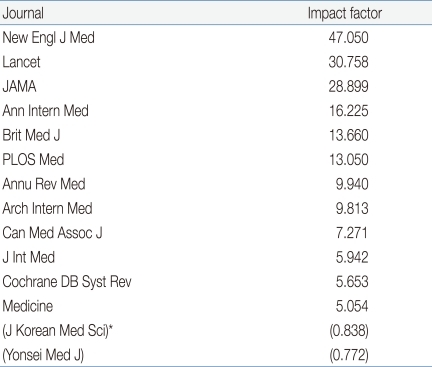All issues > Volume 54(4); 2011
Impact factor of Korean Journal of Pediatrics on Korean Medical Citation Index and Science Citation Index of Web of Science
- Corresponding author: Chong Woo Bae, M.D. Department of Pediatrics, Kyung Hee University Hospital at Gangdong, 149 Sangil-dong, Gangdong-ku, Seoul 134-727, Korea. Tel: +82.2-440-6130, Fax: +82.2-440-7175, baecw@khnmc.or.kr
- Received March 28, 2011 Accepted April 15, 2011
- Abstract
-
- Purpose
- Purpose
- The total number of times a paper is cited, also known as the impact factor (IF) of a medical journal, is widely implied in evaluating the quality of a research paper. We evaluated the citation index data as an IF of Korean J Pediatr in Korean Medical Citation Index (KoMCI) and JCI of Web of Science.
- Methods
- Methods
- We calculated the IF of Korean J Pediatr at KoMCI supervised by Korean Association of Medical Journal Editors. And we estimated the IF of Korean J Pediatr by the JCI of Web of Science although it was never officially reported.
- Results
- Results
- The IF of Korean J Pediatr on KoMCI has increased from 0.100 in the year 2000, to 0.205 in 2008, and 0.326 in 2009. Although the IF of Korean J Pediatr was 0.006 in 2005, 0.018 in 2006, 0.028 in 2008, 0.066 in 2009, and 0.018 in 2010 according to the JCI of Web of Science, the number of citations are steadily increasing.
- Conclusion
- Conclusion
- Understanding and realizing the current status will be a stepping stone for further improvement. The next objective of the Korean J Pediatr is to become registered in the SCI or SCIE. Increasing the IF according to the JCI of Web of Science is crucial in order to achieve this goal.
- Introduction
- Introduction
Publishing an article in a medical journal is to share the process of research from the start to the end in order to proclaim the conclusions one has reached. Receiving critique on the writer's observations from readers and providing guidelines for future similar studies while validating the writer's conclusions and discussions can be understood as the purpose of publishing an article in a medical journal1, 2).Additionally, an article can be used for reference when fellow colleagues and researchers adopt the contents of an article for further related research. In other words, a research paper of fine quality may be cited in more research papers and the larger the number of citations a certain article receives reflects the eminence and authority of the research material.That is why among various methods of evaluating the quality of a research paper, the number of citations a paper receives and the impact factor (IF) of a medical journal are two methods that have been widely applied. The IF is accepted as a subjective guide in evaluating a research paper.The IF is a measure estimating the average number of citations to articles published in science and social science journals. It is frequently used as a proxy for the relative importance of a journal within its field. Journals with higher IFs are considered more renowned than those with lower IFs. The impact factor was devised by Eugene Garfield, the founder of the Institute for Scientific Information, now part of Thomson Reuters3).There is the H index4), which is based on the distribution of citations received by a given researcher's publications for estimating an individual's number of citations. Internationally, there is the IF for medical journals announced by the Journal Citation Report5) with the application of Journal Citation Index (JCI) regarding journals that are categorized under the Science Citation Index (SCI) and Science Citation Index Expanded (SCIE), managed by Thomson Reuters via Web of Science. Domestically, there is the IF of Korean Medical Citation Index (KoMCI)6) managed by the Korean Association of Medical Journal Editors (KAMJE)7).Korean Journal of Pediatrics (Korean J Pediatr), which is the official publication of the Korean Pediatric Society, has been striving for further international recognition by modifying to full English publications since May 20108). The journal is already established and indexed in many databases for Korean medical journals (KoreaMed, KoreaMed Synapse, KoMCI, MedRIC, RISS, MEDLIS). Furthermore, the articles from the Korean J Pediatr are registered in international databases such as PubMed Central and Pubmed since December 20109) (indexed since May 2010), SCOPUS since Nov 2010 (indexed since January 2010)10), CAS since Nov 2010, and other organizations such as WorldWideScience.org, Crossref.org, and Google Scholar. This has played an important role in international recognition of the journal.By being abstracted and indexed on an international scale through PubMed Central and PubMed, our next objective is to be registered in the index of medical journals of SCI or SCIE. In order to achieve this goal, an increase in IF according to the JCI of Web of Science is most important. Namely, the IF of Korean J Pediatr according to the JCI of Web of Science needs to be elevated by increasing the number of citations to articles published in Korean J Pediatr.It is critical to examine the current status of Korean J Pediatr domestically and internationally according to the JCI of Web of Science to achieve the above goal. Understanding the current status will be our stepping stone to further progress and recognition.
- Materials and methods
- Materials and methods
- 1. Method of estimating the IF of Korean J Pediatr by KoMCI
- 1. Method of estimating the IF of Korean J Pediatr by KoMCI
In March 2001, Korean Academy of Medical Sciences launched the KoMCI Project to realize these goals. First, they evaluated the citation index data as an impact factor. Subsequently, the KoMCI book and CD-ROM were published. After maintaining the databases for two years, the KoMCI Project set about establishing the KoMCI Web in March 2003, a system for searching cited references in specific papers.The method of estimating IF of Korean medical journals at KoMCI supervised by KAMJE is shown in Table 17).Taking 2008 as an example, Korean J Pediatr was published monthly summing up to a total of 12 publications in 2008. Excluding case reports, the total number of articles including review articles and original publications was 204 in 2006, 181 in 2007, and 208 in 2008. The IF of Korean J Pediatr in the year of 2008 was estimated according to the method shown in Table 1.- 2. Method of estimating the IF of Korean J Pediatr by the JCI of Web of Science
- 2. Method of estimating the IF of Korean J Pediatr by the JCI of Web of Science
To the present day, the Korean J Pediatr has not been included in the Journal Citation Report of Web of Science because it is not yet classified as an SCI or SCIE journal. Therefore, writers estimated the IF of Korean J Pediatr by the JCI of Web of Science although it was never officially reported. The method of estimating the IF according to the JCI of Web of Science5) is shown in Table 2.
- Results
- Results
- 1. The IF of KoMCI
- 1. The IF of KoMCI
1) The IF of Korean J Pediatr according to KoMCI
1) The IF of Korean J Pediatr according to KoMCI
The IF of Korean J Pediatr according to KoMCI has steadily been increasing from 0.100 in the year 2000, to 0.205 in 2008 and 0.326 in 2009 (Fig. 1). Despite the overall crescendo pattern, there was a decrease in 2004. This is considered to be due to the change in the journal name from the Korean, SoAKwa, which means Pediatrics in Korean, to Korean J Pediatr, causing confusion in the process of indexing.2) Comparison of the IF of Korean J Pediatr to that of other Korean medical journals related to pediatrics
2) Comparison of the IF of Korean J Pediatr to that of other Korean medical journals related to pediatrics
The IF of subspecialty Korean medical journals related to pediatrics (J Korean Soc Pediatr Nephrol, J Korean Soc Pediatr Endoclinol, Korean J Peditr Gastroenterol Nutr, J Korean Soc Neonatol, J Korean Child Neurol Soc, Pediatr Allergy Respir Dis, Korean J Perinatol, Korean J Pediatrc Infec Dis) according to KoMCI in 2009 ranged from 0.085 to 0.357. Only J Korean Soc Pediatr Endoclinol had a higher IF than Korean J Pediatr (0.357). The remainder of the journals all had a lower IF compared to that of Korean J Pediatr, which was 0.326 (Table 3). For further reference, general medical journals such as J Korean Med Sci, J Korean Med Assoc, and Yonsei Med J had an IF of 0.231, 0.106, and 0.130, respectively.
- 2. The IF of Korean J Pediatr according to the JCI of Web of Science
- 2. The IF of Korean J Pediatr according to the JCI of Web of Science
1) The annual number of published articles of KJP
1) The annual number of published articles of KJP
The number of articles included review and original articles and excluded case reports, as shown in Table 4. An average of 160 articles including review and original articles were published. In 2010, there was a decrease in the number of articles to 120 articles.2) Annual change in numbers of Korean J Pediatr citing articles in SCI(E) journals and Korean J Pediatr cited articles
2) Annual change in numbers of Korean J Pediatr citing articles in SCI(E) journals and Korean J Pediatr cited articles
The number of citations to the Korean J Pediatr in an SCI(E) medical journal of Web of Science was 16 articles in 2008, 45 in 2009, and 80 in 2010. The distribution of annual change in numbers of Korean J Pediatr citing articles in SCI(E) journals and Korean J Pediatr cited articles is shown in Table 5.3) The IF of Korean J Pediatr according to the Journal Citation Index of Web of Science
3) The IF of Korean J Pediatr according to the Journal Citation Index of Web of Science
Based on the information of 1) and 2), the IF of Korean J Pediatr according to the JCI of Web of Science was steadily increasing from 0.006 in 2005, 0.018 in 2007, 0.028 in 2006, 0.066 in 2009, and 0.108 in 2010. The number of citations to article is still low but steadily increasing and the IF is elevating accordingly. Especially in 2010, the IF exceeded 0.100 and was estimated at 0.107 for the first time (Table 6).
- Discussion
- Discussion
The IF of Korean J Pediatr in 2009 according to KoMCI among Korean medical journal databases steadily increased from 0.100 in 2000 to 0.326 in 2009. Despite the overall crescendo pattern, there was a decrease in 2004. This is considered to be due to the change in the journal's name from the Korean, SoAKwa, which means Pediatrics in Korean, to Korean J Pediatr, causing confusion in the process of indexing. This number is relatively higher than that of other subspecialty medical journals on pediatrics and also higher compared to that of medical journals in different fields. This demonstrates how Korean J Pediatr has been established as an eminent domestic medical journal receiving a considerable amount of citations.However, the IF of Korean J Pediatr according to JCI of Web of Science in 2010 was a mere 0.108. This number is expected to increase considering Korean J Pediatr just recently became registered in international databases such as PubMed Central, PubMed and SCOPUS in 2010. For additional information, the records of IF of established and well-known medical journals according to JCI of Web of Science are shown in Table 7. In 2009, the Korean medical journals with the two highest IFs according to JCI of Web of Science are J Korean Med Sci and Yonsei Med J with IFs of 0.838 and 0.774 respectively4). Korean J Pediatr should strive for such recognition as well.In Summary, English publication of KJP has been available English publication of KJP has been available since May 20107). As a result, the journal was indexed in PubMed Central and PubMed since May 2010 and in SCOPUS since Jan 2010. This has allowed Korean J Pediatr to be searched through international medical journal databases and also implies the possibility of a rapid increase in IF according to JCI of Web of Science eventually. Being registered and indexed in SCI or SCIE medical journals can procure a wider readership. With submission of excellent articles, Korean J Pediatr will be able to receive more citations in SCI and SCIE medical journals. From this view, being indexed in PubMed Central, PubMed and SCOPUS is a significant stepping stone for Korean J Pediatr. Although the current IF of Korean J Pediatr according to JCI of Web of Science is low, further development and recognition is anticipated. We would like to encourage the readers to continue to submit excellent articles and also to cite articles from Korean J Pediatr when submitting research papers to SCI or SCIE medical journals.
- References
- 1. Hall GM. How to write a paper. 1998;2nd ed. London: BMJ Books, :15–20.2. Bae CW. How to write a medical paper. J Korean Pediatr Soc 2003;46:742–750.3. Impact factor. Wikipedia. accessed on March 2011. Wikipedia, Available from: http://en.wikipedia.org/wiki/Impact_factor.4. H-index. Wikipedia, the free encyclopedia [Internet]. 2010;accessed on March 2011. Wikipedia, the free encyclopedia, Available from: http://en.wikipedia.org/wiki/H_index.5. Journal Citation Reports. Web of Science, Thomson Reuters [Internet]. 2010;accessed on March 2011. Thomson Reuters, Available from: http://science.thomsonreuters.com/info/preorder-jcr/.6. Korean Medical Citation Index [Internet]. 2010;accessed on March 2011. Korean Medical Citation Index, Korean Association of Medical Journal editors, Available from: http://komci.org/.7. Korean Association of Medical Journal editors [Internet]. 2010;accessed on March 2011. Korean Association of Medical Journal editors, Available from: http://www.kamje.or.kr/.8. Rha YH, Lee JS. Announcement of publication of the Korean Journal of Pediatrics in English. Korean J Pediatr 2010;53:615
[Article] [PubMed] [PMC]9. Korean Journal of Pediatrics. PubMed Central journals accessed on March 2011. Available from: http://www.ncbi.nlm.nih.gov/pmc/journals/1387/.10. Korean Journal of Pediatrics. SCOPUS accessed on March 2011. Available from: http://www.scopus.com/source/browse.url?zone=TopNavBar&origin=searchbasic.
Fig. 1
Change in impact factors of Korean Journal of Pediatrics by Korean Medical Citation Index (KoMCI).
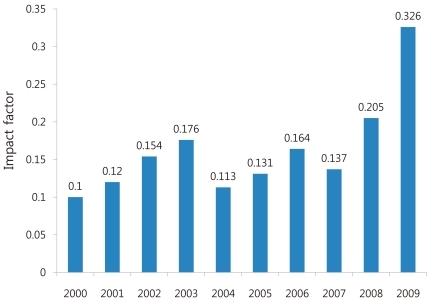
Table 1
Impact Factor of Korean Journal of Pediatrics by Korean Medical Citation Index (KoMCI) in 2008
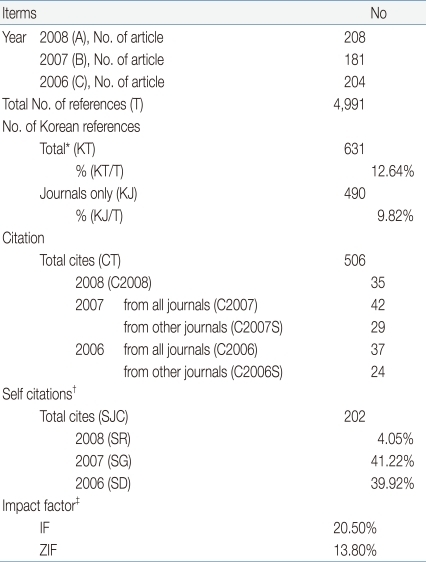
Table 2
Impact Factor of X-journal by Journal Citation Index of Web of Science, Thomson Reuters (for example)
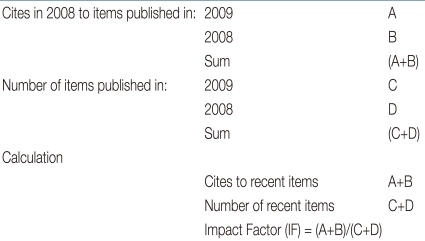
Table 3
Impact Factors of Pediatric Journals and Others in Korea by Korean Medical Citation Index (KoMCI) in 2009
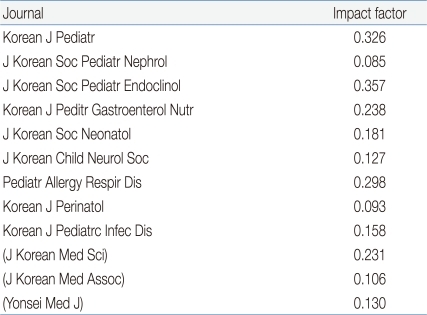
Table 5
Numbers of Korean Journal of Pediatrics Citing Articles in Science Citation Index or Science Citation Index Expanded Journals and Korean Journal of Pediatrics Cited Articles


 About
About Browse articles
Browse articles For contributors
For contributors

